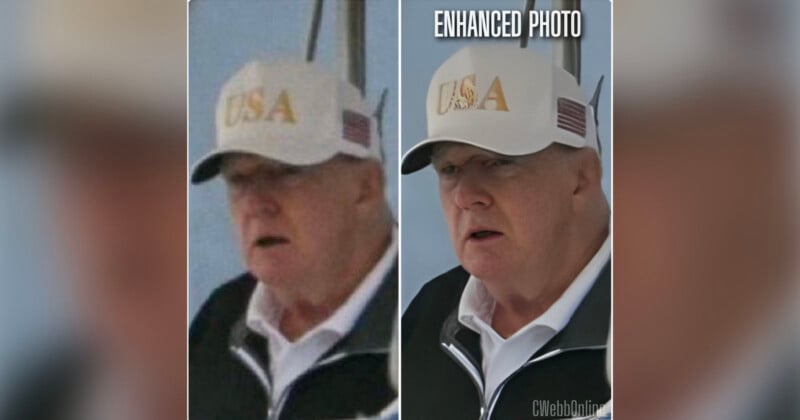Trump Photo Shows The Perils of AI Upscaling Tools

Over the Labor Day weekend, rumors swirled about President Trump’s health. On Monday, Getty Images photographer Andrew Caballero-Reynolds captured a grainy image of Trump leaving the White House.
The photo that was taken by Caballero-Reynolds, a member of the White House Press Pool, showed Trump on his way to the Trump National golf course in Sterling, Virginia.
But internet sleuths who had worked themselves into a frenzy — convinced the president was having a health crisis — examined the images carefully. One X user, Christopher Webb, took one of the images and ran it through a tool that uses AI to upscale images.
“I enhanced the image. And seriously, can an expert explain what the hell is happening to his forehead? Right above his nose and right brow,” Webb writes on the platform formerly known as Twitter in a post that was seen by 4.2 million people.
Upscaling an image enlarges the dimensions by interpolating pixels using machine learning AI technology. Its success rate very much depends on the program being used and the quality of the source material; it can often go terribly wrong.
France 24 reports that Webb’s AI upscaling “went wrong,” citing BBC journalist Shayan Sardarizadeh.
“What’s happened here is that you zoomed in on Trump’s face in what’s already a low-resolution, grainy photo,” Sardarizadeh explains. “You’ve then used AI to upscale that grainy image, which has resulted in AI distorting the photo. Never mind the face, see what AI’s done to ‘USA’ and the flag on his hat.”
What's happened here is that you zoomed in on Trump's face in what's already a low-resolution, grainy photo.
You've then used AI to upscale that grainy image, which has resulted in AI distorting the photo. Never mind the face, see what AI's done to USA and the flag on his hat. https://t.co/DfaaEaUscp
— Shayan Sardarizadeh (@Shayan86) September 2, 2025
Essentially, whatever AI upscaling tool Webb used did a terrible job, and the strange artifacts it added to Trump’s face as it attempted to salvage the image potentially misled millions of people.
“The photo is compressed and shows very smooth skin. So it’s clear that if the details don’t exist in the original image, the upscaling tool will have to reinvent them,” Ari Kouts, an innovation and AI consultant, tells France 24. “Overall, the problem with these tools is that they inevitably have to invent, or at least recreate, details that were or were not there.”
The Community Notes system on X did slap a context note on Webb’s post stating that, “AI-upscaled images are not trustworthy. AI commonly creates and distorts detail when ‘enhancing’ lower resolution source images.”
Nevertheless, AI upscaling tools are popular. Adobe recently rolled out Generative Upscale, which uses Adobe’s Firefly generative AI to upscale images with improved sharpness, clarity, and resolution.